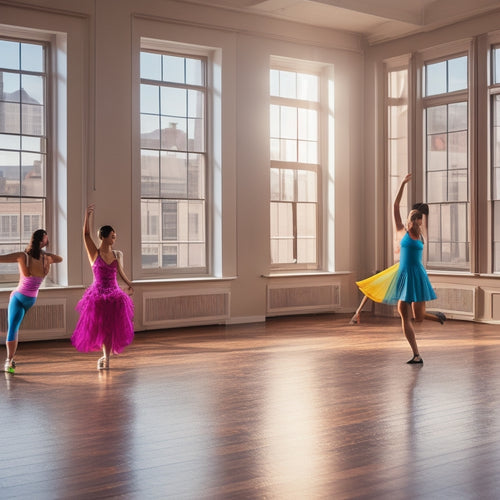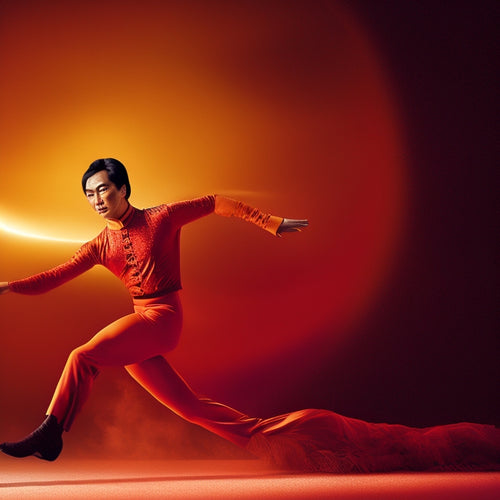
Do You Wear Socks Under Dance Shoes?
Share
You're wondering whether to wear socks under your dance shoes. The answer isn't a simple yes or no. Socks can provide comfort, prevent blisters, and keep your feet dry, but they can also restrict movement and cause slipping on certain floors. It ultimately depends on your personal preferences, the dance style, and the demands of the performance. Consider factors like sweat, blisters, and cultural norms when deciding. As you weigh the pros and cons, you'll want to explore the nuances of finding the right balance between comfort, support, and performance – and there's more to discover.
Key Takeaways
• Wearing socks under dance shoes can prevent blisters, keep feet dry, and provide additional comfort, but may restrict movement and cause slipping.
• The decision to wear socks depends on personal preferences, cultural influences, and the demands of the dance style, including sweat and blister prevention.
• Socks can impact performance and comfort level, and finding what works best for individual comfort is crucial.
• Dance shoes require the right socks for comfort and support, providing ankle stability, arch protection, and freedom of movement.
• Experimenting with different options, considering the specific demands of the dance style, and prioritizing personal comfort level can help make the decision.
Socks for Comfort and Support
When you slip on your dance shoes, the right socks can make all the difference in providing comfort and support during your performance. You want to feel free to move without restrictions, and the right socks can give you that freedom.
Look for socks that provide ankle stability, which is vital for dancers who need to pivot, turn, and jump. Arch protection is also essential, as it helps prevent fatigue and discomfort.
The Case Against Socks
Ditching socks altogether can be a deliberate choice for dancers seeking to maximize proprioception and develop a more nuanced connection with their shoes and the floor. You might want to forego socks to feel more grounded and connected to the floor, which can be especially important in styles that require intricate footwork or precise movements.
Plus, going sockless can be a fashion statement, allowing your shoes to take center stage. It's also a matter of personal preference - if you're someone who values freedom of movement and hates the feeling of restricted toes, then skipping socks might be the way to go.
Ultimately, it's about what makes you feel confident and comfortable in your dance shoes.
Dance Shoe Fit and Sizing
Your dance shoes should fit snugly, like a second skin, to guarantee peak support and allow you to move freely and confidently. A proper fit guarantees you can focus on your dance moves, not on adjusting your shoes. When trying on dance shoes, consider the following factors:
| Shoe Aspect | Fit Considerations | Tips |
|---|---|---|
| Shoe width | Ensure a comfortable fit, neither too tight nor too loose | Try on shoes in the afternoon, as feet tend to swell throughout the day |
| Heel shape | Choose a heel shape that supports your ankle and allows for smooth movements | High heels can be challenging; practice walking in them before dancing |
| Toe box | Ensure enough room for your toes to wiggle without feeling cramped | Avoid shoes that put pressure on your toes, causing discomfort |
Sweat and Blister Prevention
Properly wearing socks under your dance shoes can greatly reduce sweat and blister formation, allowing you to focus on perfecting your technique.
By choosing socks with moisture management properties, you'll keep your feet dry and comfortable, reducing the likelihood of blisters. Additionally, socks with friction reduction features can help minimize rubbing and irritation.
When you wear socks that provide a smooth, seamless fit, you'll experience less friction and discomfort. This means you can dance with freedom and confidence, without worrying about painful blisters or sweaty feet.
Traction and Grip Considerations
When you're dancing, you need to be able to trust your shoes to grip the floor. That's why it's important to take into account the traction and grip of your dance shoes, especially when wearing socks underneath.
Now, let's break down the key factors that affect grip, from slip-resistant soles to grip patterns and sole material options, to make sure you're getting the right amount of traction for your style of dance.
Slip-Resistant Soles Matter
Traction and grip considerations become paramount when selecting dance shoes, as a slip-resistant sole can make all the difference between a confident performance and a disastrous fall. You want to make sure your shoes provide the necessary grip to prevent slipping on various floor types, especially those with high-gloss finishes.
Shoe technology has advanced greatly, and many dance shoes now feature innovative outsoles designed for floor safety. Look for shoes with specialized rubber compounds and tread patterns that provide maximum grip on different surfaces. By choosing shoes with slip-resistant soles, you'll enjoy greater freedom of movement and peace of mind, allowing you to focus on perfecting your craft.
Grip Patterns Explained
As you explore dance shoes with slip-resistant soles, you'll notice various grip patterns designed to address specific floor types and performance needs. These patterns are a critical aspect of sole technology, providing the necessary traction for best movement.
You may find circular grooves for smooth floors, herringbone patterns for added grip on wooden surfaces, or unique designs for specific dance styles. Shoe customization allows for tailored grip patterns to suit your individual needs.
Sole Material Options
Your dance shoes' sole material plays a pivotal role in maintaining peak grip and traction, with options ranging from soft, flexible rubber to durable, high-wear-resistant synthetic materials. As you dance, you need a sole that can keep up with your moves, providing the right amount of grip and support.
Here are some key considerations for sole material options:
-
Sole Durability: Look for materials that can withstand high-impact movements and frequent use.
-
Material Innovation: Advances in technology have led to the development of lightweight, high-grip materials that enhance performance.
-
Traction Control: Soles with specialized tread patterns can help you maintain control on various dance floors.
- Customization: Some dance shoes offer interchangeable soles, allowing you to adapt to different dance styles and surfaces.
Different Dance Styles, Different Needs
You'll find that different dance styles place unique demands on your feet, and as a result, on your socks and shoes. For instance, ballet requires a snug fit to prevent blisters, while hip-hop needs extra cushioning to absorb high-impact movements. Cultural significance also plays a role, as some styles require specific footwear or sock choices. Additionally, age limitations come into play, as younger dancers may need more support and protection.
| Dance Style | Sock and Shoe Requirements |
|---|---|
| Ballet | Snug fit, thin socks, and soft shoes |
| Hip-Hop | Cushioned socks, high-top shoes, and ankle support |
| Ballroom | Thin socks, smooth shoes, and heel support |
| Contemporary | Breathable socks, flexible shoes, and arch support |
Hygiene and Foot Health
Proper foot hygiene is essential in preventing fungal and bacterial infections, which can be exacerbated by sweaty feet confined in socks and shoes. As you dance, your feet are more prone to sweating, creating a perfect breeding ground for fungal infections like athlete's foot. This can lead to foot odor, discomfort, and embarrassment.
To maintain good foot health, remember:
- Wash your feet daily with soap and water.
- Dry them thoroughly, especially between the toes.
- Change your socks regularly, especially after intense dance sessions.
- Use an antifungal powder or spray to keep your feet dry and fresh.
Professional Dancers Weigh In
Many professional dancers swear by wearing socks under their dance shoes, citing benefits that range from improved comfort to enhanced performance. As a dancer, you're likely no stranger to the physical and mental demands of a dance career. Wearing socks can be a game-changer for your performance psychology.
| Professional Dancer | Socks or No Socks? |
|---|---|
| Sarah, Ballet Dancer | Always wears socks for added comfort and support |
| John, Contemporary Dancer | Never wears socks to maintain direct connection with the floor |
| Emily, Ballroom Dancer | Wears socks for competitions, but not for practice |
| Michael, Hip-Hop Dancer | Prefers no socks for better grip and control |
| Rachel, Modern Dancer | Wears socks for rehearsals, but not for performances |
These dancers' experiences demonstrate the variety of opinions on wearing socks under dance shoes.
Making the Right Choice for You
When determining whether wearing socks under your dance shoes is right for you, take into account the specific demands of your dance style and the personal comfort level you need to perform at your best.
When making your decision, keep in mind that it's all about finding what works for you. Here are a few factors to take into account:
-
Personal preferences: Do you prefer the feel of socks or going barefoot?
-
Cultural influences: Are you dancing in a style that traditionally wears socks, like ballet, or one that doesn't, like hip-hop?
-
Sweat and blisters: Will socks help prevent blisters or keep your feet dry in high-intensity dances?
- Freedom of movement: Will socks restrict or enhance your movements?
Frequently Asked Questions
Can I Wear Socks With Holes in Them Under Dance Shoes?
"As you prepare to slip on those dance shoes, you wonder: can you really wear socks with holes in them? The answer lies in your hole tolerance and sock hygiene habits - the verdict may surprise you!"
Do Dance Shoes Come With Insoles for Added Arch Support?
You'll find that most dance shoes don't come with insoles for added arch support, but you can always purchase custom insoles tailored to your arch variations, ensuring sole comfort and freedom of movement.
Can I Wear Dance Shoes Without Socks in Cold Weather?
Did you know that 75% of dancers experience cold toes during winter performances? You can wear dance shoes without socks in cold weather, but be prepared for chilly toes; consider thermal insoles or heated foot warmers for Winter dancing comfort.
Do Socks Affect the Break-In Period of New Dance Shoes?
When breaking in new dance shoes, you'll find that socks made from breathable materials can reduce foot sweat, allowing for a more precise fit and minimizing fit adjustments, while also reducing sole sensitivity and facilitating a more comfortable shoe stretch.
Can I Wear Athletic Socks Instead of Dance Socks?
"Did you know 75% of dancers prioritize comfort over style? When opting for athletic socks, consider the material and thickness: moisture-wicking fabrics and thin profiles are ideal, but may not provide the same support as dance socks."
Related Posts
-

The King Manual: Your Ultimate Knowledge Companion
The King Manual: Your Ultimate Knowledge Companion is an all-encompassing resource that opens up the power of knowled...
-

Top New Balance Dance Shoes for Comfort and Performance
If you're on the hunt for top New Balance dance shoes that maximize comfort and performance, consider models like the...
-

Captivating Insights: Maos Last Dancer Analysis
Li Cunxin's memoir, Mao's Last Dancer, is a compelling narrative that delves into the intersection of art, identity, ...


